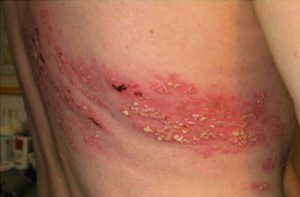SHINGLES (HERPES ZOSTER)
Shingles, also known as herpes zoster, comes from the same virus that causes chickenpox. Therefore anyone who’s had chickenpox can develop this eruption later in life. After having chickenpox, the virus remains in a dormant state in certain nerve cells of the body and then reactivates, causing zoster. About 20 percent of the population is affected at some time during their lives.
What prompts the virus to “awaken” and cause problems in normal, healthy people is not clear. Most physicians believe there is temporary weakness in the body’s ability to fight off disease. This allows the virus to move along the nerve fibers toward the skin. The fact that the disease occurs more often in people older than age 50 (although children can get it, too) supports this since the immune response is believed to be weaker in older people. Trauma or possibly stress may also trigger a zoster attack.
People whose ability to ward off disease is weakened are more prone to develop zoster. They are also more likely to have a serious form of it. This includes some people with cancer, such as leukemia or lymphoma, or who have undergone chemotherapy or radiation therapy for cancer. People who have had organ transplants and are taking drugs to ward off transplant rejection may also be more susceptible, as well as those with diseases that affect the immune system, such as AIDS. The majority of people who develop zoster, however, are otherwise healthy.
Scarring usually does not occur. However, in persons who have more severe infections, such as those with weakened immune systems, elderly persons, or those with blisters become infected may have some scarring. About 20 percent of those people who have had chicken pox will get zoster. Most people get zoster only once.
What are the signs of an outbreak?
Early signs of a shingles outbreak are often vague, and can easily be mistaken for other illnesses. The first sign of an attack can be an isolated pain, burning sensation, “tingling” sensation, numbness in a major nerve in or under the skin, or even a “shooting” pain around the trunk or down the arm or leg. Mild flu-like symptoms, such as headache, fever and upset stomach, may also occur.
At this point, these symptoms can be confused with other illnesses, such as an ulcer, ruptured disc, pneumonia, appendicitis, or even a heart attack. However, as the outbreak progresses, the symptoms become clear and the diagnosis is made more definite.

Lesions (rash) appear on the skin from one to 14 days later, usually in a band on one side of the body or back, or clustered on one side of the face. The number of lesions varies from person to person. These lesions become fluid-filled blisters in two to four days. They continue appearing for several more days and then turn from clear to cloudy in appearance as white blood cells attack the virus.
Eventually, all the blisters crust, scab and heal, most often within a few weeks. Vision and hearing problems are less common, but equally serious, and can occur whenever shingles appear on the face. If this happens, one should see a doctor immediately. If shingles affect the eye, it can cause temporary or permanent blindness through infection of the cornea or retina.
Is zoster contagious?
The virus that causes zoster can be passed on to others, but they will develop chickenpox, not zoster and only if they have not had chicken pox. Zoster is much less contagious than chicken pox. Persons with zoster can only transmit the virus if blisters are broken and someone who never has had chicken pox or who already is ill is close by. Pregnant women, newborns, or those who already are ill or immunosuppressed, such as cancer patients, are at the highest risk. Because of the risk of contagion for these people, these patients with zoster are rarely hospitalized unless absolutely necessary. In pregnancy, Zoster can potentially cause major problems to the newborn baby.
What about treatment?
In most people with zoster, the condition clears on its own in a few weeks and seldom recurs. Treatment is helpful however because it can speed up the recovery time. Treatment consists of pain relievers as well as cool compresses to help dry the blisters. Dr. Green prescribes several highly effective medications for zoster.
Probably the most common problem of herpes zoster is post-herpetic neuralgia. The associated pain, numbness, itching, and tingling can last for months or even years. It is more common in older people. Seeking treatment quickly can help alleviate the condition and decrease the potential risk for post-herpetic neuralgia.
Vaccination against Herpes Zoster
A vaccine has been newly approved by the U.S. Food and Drug Administration (FDA) for persons aged 60 years and older who have never had zoster. In one study, this immunization decreased the incidence of shingles by more than 50 percent. This vaccine has not been studied in persons with a history of shingles, and it should not be given to people who have decreased immunity (e.g., HIV, active cancer, taking drugs that decrease the immune response, etc.
The vaccination is offered in the offices, just ask the doctor if you are an ideal candidate.



